Table of Contents
- Why Outdoor Games Matter for Young Learners
- Physical Development Through Play
- 25 Essential Outdoor Games
- Creating Safe Outdoor Learning Spaces
- Seasonal Adaptations
- Equipment Recommendations
- Conclusion
Outdoor games for preschoolers represent far more than simple entertainment—they form the foundation of early childhood development. When children engage in structured outdoor play, they develop critical motor skills, social competencies, and cognitive abilities that prepare them for lifelong learning success.
Research from the Outdoor Classroom Day initiative reveals that 88% of educators report higher student engagement when lessons occur outdoors. This statistic underscores why forward-thinking early childhood centers increasingly prioritize outdoor learning environments equipped with quality educational toys and play equipment.
Why Outdoor Games Matter for Young Learners
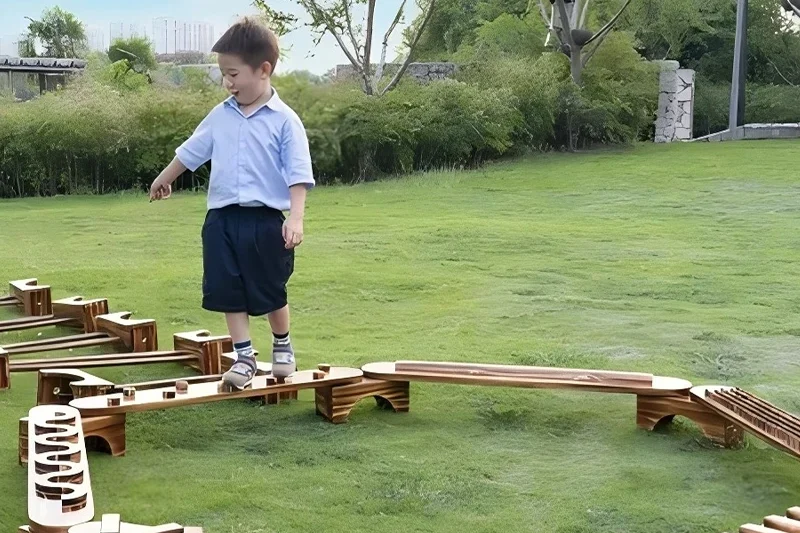
Outdoor games for preschoolers deliver multifaceted developmental benefits that indoor activities simply cannot replicate. According to the American Academy of Pediatrics, children require at least 60 minutes of unstructured outdoor play daily for optimal health and development.
Core Benefits of Outdoor Play:
Physical Development: Running, jumping, climbing, and balancing activities strengthen cardiovascular systems, build muscle tone, and enhance coordination. These movements form the foundation for future athletic abilities and lifelong fitness habits.
Cognitive Growth: Natural environments stimulate curiosity and problem-solving. When children manipulate outdoor play equipment, they learn cause-and-effect relationships, spatial awareness, and basic physics principles through hands-on experimentation.
Social-Emotional Learning: Group outdoor games for preschoolers teach cooperation, turn-taking, conflict resolution, and empathy. These interpersonal skills prove essential for classroom success and future relationships.
Sensory Integration: Outdoor environments provide rich multisensory experiences—textured surfaces, varied temperatures, natural sounds, and changing light conditions—that support neurological development and body awareness.
Physical Development Through Play

Quality outdoor equipment designed specifically for early childhood education amplifies these developmental benefits. Wooden educational toys and natural play structures offer several advantages over plastic alternatives:
- Durability: Sustainably-sourced wooden equipment withstands years of intensive use in institutional settings
- Safety: Natural materials reduce injury risks and environmental toxins
- Sensory Richness: Wood’s varied textures support tactile development
- Educational Value: Natural materials connect children with environmental awareness
Leading kindergartens and early childhood education centers now specify wooden play equipment in their outdoor learning spaces, recognizing these long-term value propositions.
25 Essential Outdoor Games for Preschoolers
Active Movement Games
1. Classic Hopscotch with Number Recognition
Outdoor games for preschoolers frequently incorporate classic activities with educational twists. Hopscotch combines physical exercise with mathematics learning.
How to Play:
- Draw numbered squares (1-10) on pavement using sidewalk chalk
- Children toss a small beanbag onto numbered squares
- Players hop through the grid on one foot, skipping the marked square
- Retrieve the beanbag on the return journey
Skills Developed: Balance, number recognition, sequential thinking, spatial awareness
Equipment Needed: Sidewalk chalk, beanbags
Educational Enhancement: Call out numbers for children to hop to, reinforcing number identification and listening skills.
2. Nature Scavenger Hunt
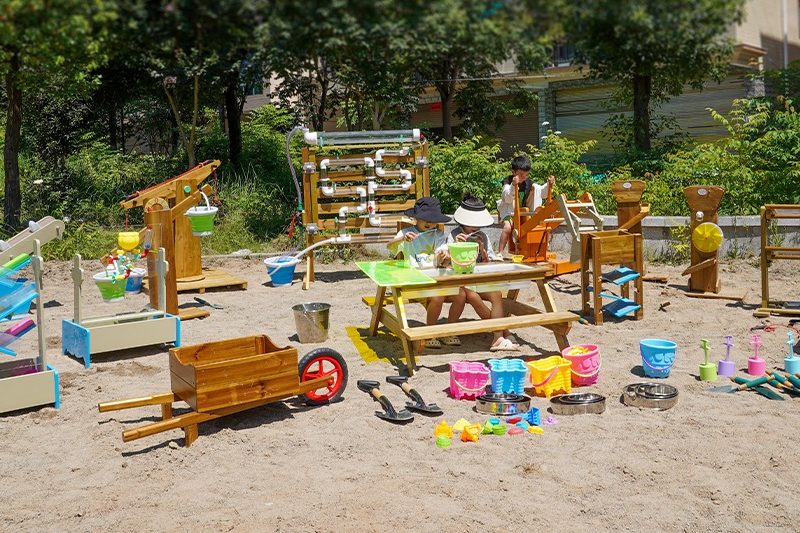
This investigation-based activity transforms outdoor spaces into living classrooms. Nature scavenger hunts rank among the most educational outdoor games for preschoolers.
How to Play:
- Create picture-based lists showing leaves, rocks, flowers, pinecones, and feathers
- Provide wooden collection baskets for each child
- Guide children through designated areas, helping identify items
- Gather to discuss findings and create nature art displays
Skills Developed: Observation, categorization, vocabulary building, environmental awareness
Equipment Needed: Picture cards, collection containers, magnifying glasses
Safety Note: Supervise closely and pre-check areas for hazards like poison ivy or sharp objects.
According to ChildCare.gov, nature-based learning activities significantly enhance preschoolers’ scientific thinking and environmental stewardship.
3. Wooden Balance Beam Walking
Balance activities form crucial components of gross motor development. Quality wooden balance beams provide safe, effective outdoor games for preschoolers.
How to Play:
- Set up low wooden balance beams (4-6 inches high) on level ground
- Children walk forward, backward, and sideways across beams
- Add challenges: carry beanbags, balance with arms extended, walk heel-to-toe
Skills Developed: Balance, body control, confidence, spatial awareness, risk assessment
Equipment Needed: Wooden balance beams, safety mats
Progression Tips: Start with ground-level lines, advance to low beams, then elevated beams as confidence builds.
4. Parachute Play Games
Group parachute activities create joyful, cooperative outdoor games for preschoolers that build community and teamwork.
How to Play:
- Children hold parachute edges at waist height
- Bounce lightweight balls on the parachute surface
- Create “mushrooms” by lifting parachute high and pulling down quickly
- Run underneath during “popcorn” activities
Skills Developed: Upper body strength, cooperation, rhythm, visual tracking
Equipment Needed: Large play parachute, lightweight balls
Group Size: Works best with 8-15 children for proper parachute control.
Cognitive Development Games
5. Color Sorting Garden Game

Outdoor games for preschoolers that incorporate color recognition support early mathematics and classification skills.
How to Play:
- Place colored hoops or wooden sorting trays in outdoor space
- Provide colored balls, blocks, or natural objects
- Children sort items into matching color groups
- Count objects in each group together
Skills Developed: Color recognition, classification, counting, decision-making
Equipment Needed: Colored hoops or wooden sorting trays, assorted colored objects
Extension Activity: Create color patterns or graphs showing quantities of each color found.
6. Simon Says Outdoor Edition
This traditional listening game becomes enhanced when played in open outdoor spaces. Simon Says ranks among the most versatile outdoor games for preschoolers.
How to Play:
- Leader gives commands starting with “Simon says…”
- Children follow only commands preceded by this phrase
- Actions include: jumping, spinning, touching ground, reaching high
- Rotate leadership to different children
Skills Developed: Listening comprehension, impulse control, following directions, body awareness
Equipment Needed: None required
Variation: Incorporate animal movements (hop like bunny, waddle like duck) for added engagement.
Research from Zero to Three confirms that listening games strengthen executive function skills essential for school readiness.
7. Alphabet Treasure Hunt
Combining literacy with physical activity creates powerful learning experiences. This ranks among the most educational outdoor games for preschoolers.
How to Play:
- Hide large wooden alphabet letters throughout play area
- Children search for specific letters called out
- Found letters are matched to corresponding objects or pictures
- Create words using collected letters
Skills Developed: Letter recognition, phonemic awareness, memory, problem-solving
Equipment Needed: Wooden alphabet letters, picture cards
Educational Value: Bridges literacy learning with kinesthetic movement for multi-sensory letter mastery.
8. Number Jump Challenge
Mathematical thinking develops naturally through active outdoor games for preschoolers that incorporate number concepts.
How to Play:
- Arrange numbered wooden stepping stones or chalked circles (1-20)
- Call out numbers for children to jump to
- Create sequences: “Jump to 3, then 5, then 7”
- Practice skip counting by 2s or 5s
Skills Developed: Number recognition, sequential thinking, numerical ordering, physical coordination
Equipment Needed: Numbered stepping stones or sidewalk chalk
Assessment Opportunity: Observe which numbers children consistently identify and which require additional practice.
Social-Emotional Learning Games
9. Cooperative Obstacle Course
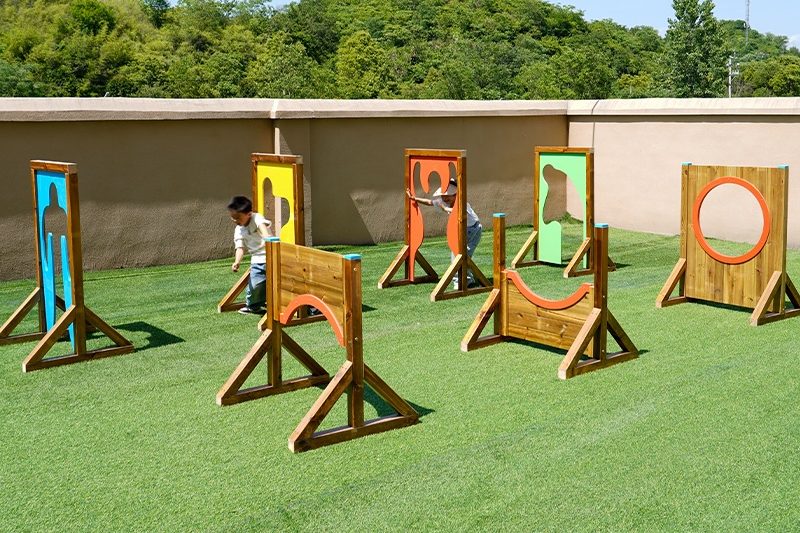
Teamwork-focused outdoor games for preschoolers build social competencies while developing physical skills.
How to Play:
- Set up course stations: tunnel crawl, balance beam, cone weaving, jump zones
- Partners work together to complete course
- One child performs action while partner cheers and supports
- Teams trade roles at each station
Skills Developed: Cooperation, encouragement, patience, gross motor skills
Equipment Needed: Tunnels, balance beams, cones, wooden hurdles
Time Management: Rotate groups every 3-5 minutes to maintain engagement.
10. Friendship Circle Ball Pass
Building positive peer relationships through structured outdoor games for preschoolers strengthens classroom community.
How to Play:
- Children sit in circle formation
- Pass soft ball around circle while music plays
- When music stops, child holding ball shares something positive about neighbor
- Continue rotation to ensure every child receives recognition
Skills Developed: Turn-taking, verbal expression, positive social interaction, emotional vocabulary
Equipment Needed: Soft ball, music player
Emotional Learning: Teaches children to notice and articulate positive qualities in peers.
11. Musical Hoops
This adaptation of musical chairs eliminates competition while maintaining engagement. It exemplifies inclusive outdoor games for preschoolers.
How to Play:
- Scatter colored hoops across play area (one per child)
- Children walk around hoops while music plays
- When music stops, everyone finds a hoop to stand in
- Remove hoops gradually, having children share hoops cooperatively
- Goal: Entire group fits in one hoop by game end
Skills Developed: Cooperation, problem-solving, spatial awareness, sharing
Equipment Needed: Colored hoops, music player
Cooperative Focus: Emphasizes working together rather than elimination-based competition.
According to the Collaborative for Academic, Social, and Emotional Learning, cooperative games significantly improve preschoolers’ emotional regulation and relationship skills.
Creative Expression Games
12. Outdoor Art Station

Creative outdoor games for preschoolers that incorporate art experiences support fine motor development and self-expression.
How to Play:
- Set up wooden easels or clipboards in outdoor space
- Provide washable paints, large brushes, and paper
- Encourage children to paint observations from nature
- Incorporate natural materials: leaves as brushes, flowers as stamps
Skills Developed: Fine motor control, color mixing, creative expression, observational skills
Equipment Needed: Wooden easels, washable paints, brushes, paper, natural materials
Art Extension: Display finished works in outdoor gallery for parent viewing.
13. Shadow Drawing Game
This science-art combination creates memorable outdoor games for preschoolers that teach about light and shadows.
How to Play:
- On sunny days, children stand in specific poses
- Partners trace shadows with sidewalk chalk
- Fill tracings with patterns, colors, or details
- Revisit later to observe shadow movement and changes
Skills Developed: Scientific observation, artistic expression, understanding of light, spatial awareness
Equipment Needed: Sidewalk chalk, sunny day
Scientific Learning: Discuss why shadows move throughout the day, introducing basic astronomy concepts.
14. Nature Sculpture Building
Loose parts play forms the basis of many effective outdoor games for preschoolers, encouraging open-ended creativity.
How to Play:
- Provide natural materials: sticks, stones, leaves, pinecones, bark
- Children create freestanding sculptures or designs
- Photograph creations before disassembling
- Discuss design choices and structural challenges encountered
Skills Developed: Creativity, problem-solving, engineering thinking, persistence
Equipment Needed: Natural loose parts, wooden building blocks (optional)
STEM Connection: Introduces basic engineering principles of balance and stability.
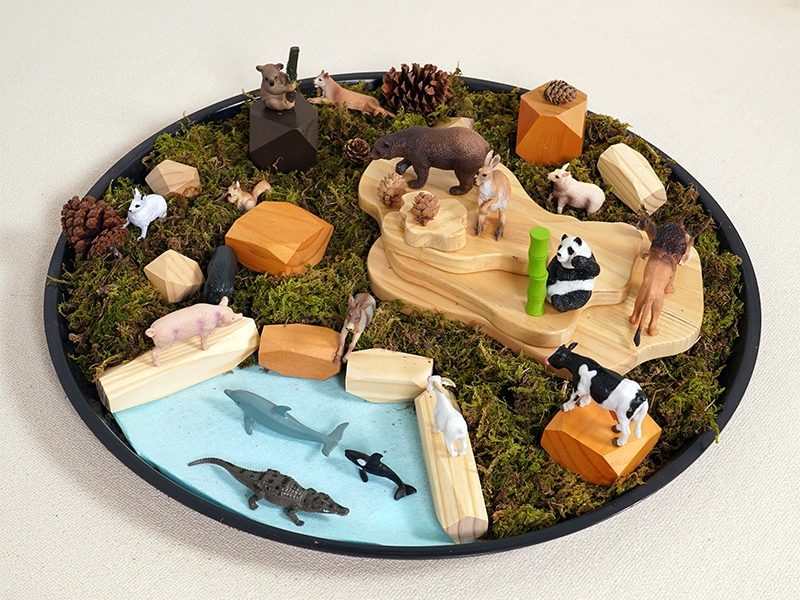
Sensory Exploration Games
15. Barefoot Sensory Path
Sensory-focused outdoor games for preschoolers support neurological development and body awareness.
How to Play:
- Create path sections with different textures: grass, sand, smooth stones, bark chips
- Children remove shoes and walk slowly through each section
- Describe sensations experienced in each area
- Repeat journey with eyes closed for heightened awareness
Skills Developed: Sensory discrimination, vocabulary development, body awareness, mindfulness
Equipment Needed: Various natural textures, wooden edging to define path
Safety Consideration: Inspect path carefully for sharp objects before barefoot use.
The American Occupational Therapy Association recognizes sensory play as essential for healthy neurological development in early childhood.
16. Water Play Exploration
Water-based outdoor games for preschoolers provide rich sensory experiences while teaching scientific concepts.
How to Play:
- Set up water tables or large containers with water
- Provide various tools: funnels, cups, scoops, squeeze bottles, wooden boats
- Children experiment with pouring, floating, sinking, and measuring
- Add natural materials like flowers or leaves for additional exploration
Skills Developed: Hand-eye coordination, cause-and-effect understanding, measurement concepts, scientific inquiry
Equipment Needed: Water tables, containers, various water tools, wooden boats
Science Learning: Discuss concepts of floating/sinking, volume, and water properties.
17. Sound Scavenger Hunt
Auditory discrimination activities rank among the most developmentally appropriate outdoor games for preschoolers.
How to Play:
- Children close eyes and listen for one minute
- Identify different sounds: birds, wind, vehicles, voices, insects
- Create list or drawings representing sounds heard
- Discuss which sounds are natural versus human-made
Skills Developed: Listening discrimination, environmental awareness, classification, attention
Equipment Needed: None required (optional: clipboards for recording)
Mindfulness Element: Teaches children to pause and consciously attend to their environment.
Gross Motor Development Games
18. Beanbag Toss Target Game
Throwing activities form essential components of gross motor outdoor games for preschoolers.
How to Play:
- Set up wooden target boards with various sized holes at different distances
- Children toss beanbags attempting to land in targets
- Assign points or colors to different holes
- Track progress as throwing accuracy improves
Skills Developed: Hand-eye coordination, throwing technique, distance estimation, fine motor control
Equipment Needed: Wooden target boards, beanbags in various colors
Progression: Start with large, close targets; advance to smaller, more distant targets.
19. Wooden Ring Toss Challenge
This classic game strengthens upper body control and is ideal as one of many versatile outdoor games for preschoolers.
How to Play:
- Position wooden ring toss stands at appropriate distances
- Children throw rings attempting to land them on posts
- Vary distances to provide differentiated challenges
- Encourage two-handed and one-handed throwing techniques
Skills Developed: Upper body strength, aiming skills, spatial judgment, frustration tolerance
Equipment Needed: Wooden ring toss sets with various post heights
Skill Building: Practice underhand and overhand throws for comprehensive development.
20. Relay Race Variations
Team-based outdoor games for preschoolers that involve relay formats teach cooperation while building speed and coordination.
How to Play:
- Animal Relay: Hop like bunny, crawl like bear, waddle like duck to destination
- Object Carry: Transport beanbags, balls, or wooden blocks in various ways
- Balance Challenge: Walk heel-to-toe while carrying object on wooden spoon
- Partner Relay: Connect with partner via hula hoop and move together
Skills Developed: Gross motor skills, cooperation, following multi-step directions, creative movement
Equipment Needed: Cones for markers, beanbags, balls, wooden spoons, hula hoops
Inclusive Adaptation: Ensure all children experience success by adjusting distances and challenges.
Problem-Solving Games
21. Wooden Block Tower Building

Construction-based outdoor games for preschoolers develop spatial reasoning and engineering thinking.
How to Play:
- Provide large wooden building blocks of various shapes
- Challenge children to build tallest tower, longest wall, or specific structure
- Work individually or in cooperative groups
- Photograph structures before carefully deconstructing
Skills Developed: Spatial reasoning, problem-solving, engineering concepts, collaborative planning
Equipment Needed: Large wooden building blocks in varied shapes
STEM Integration: Discuss concepts of balance, stability, shapes, and structural integrity.
Educational research published in Early Childhood Research Quarterly demonstrates that block play significantly enhances mathematical thinking in preschoolers.
22. Puzzle Path Challenge
Cognitive outdoor games for preschoolers that incorporate problem-solving keep minds actively engaged.
How to Play:
- Create “puzzle stations” throughout outdoor space
- At each station, children solve age-appropriate puzzles: matching, sequencing, shape sorting
- Use wooden educational puzzles designed for outdoor use
- Completing puzzle reveals clue to next station location
Skills Developed: Problem-solving, perseverance, visual discrimination, logical thinking
Equipment Needed: Weather-resistant wooden puzzles, station markers
Educational Differentiation: Provide varying puzzle difficulties to accommodate different skill levels.
Language Development Games
23. Story Stone Creation and Telling
Literacy-focused outdoor games for preschoolers that combine art and storytelling build narrative skills.
How to Play:
- Children paint images on smooth stones: animals, people, objects, settings
- Once dry, place stones in basket or wooden box
- Children select stones and create stories incorporating chosen images
- Share stories with group, building oral language skills
Skills Developed: Narrative structure, vocabulary, creative thinking, verbal expression, sequencing
Equipment Needed: Smooth stones, washable paints, brushes, storage container
Literacy Connection: Stories can be dictated by teacher and compiled into class book.
24. Outdoor Poetry Walk
Language-rich outdoor games for preschoolers that incorporate literary elements develop appreciation for language.
How to Play:
- Walk through outdoor space observing seasonal changes
- Stop at various points to describe observations using descriptive language
- Create simple group poems about nature observations
- Record poems on large paper for display
Skills Developed: Descriptive language, observation skills, listening, collaborative creation
Equipment Needed: Clipboard, large paper, markers
Literary Elements: Introduce simple concepts like rhyme, rhythm, and alliteration.
Seasonal Adaptation Games
25. Four Seasons Nature Collection
Year-round outdoor games for preschoolers that highlight seasonal changes teach environmental awareness and observational skills.
How to Play:
- Spring: Collect flowers, new leaves, observe birds building nests
- Summer: Gather shells (if near water), colorful leaves, watch butterflies
- Fall: Collect colorful leaves, acorns, observe migrating birds
- Winter: Search for evergreen branches, pinecones, animal tracks in snow
Skills Developed: Seasonal awareness, environmental observation, classification, scientific thinking
Equipment Needed: Wooden collection trays with compartments, magnifying glasses
Documentation: Photograph seasonal collections and create comparison displays showing changes throughout year.
Creating Safe Outdoor Learning Spaces
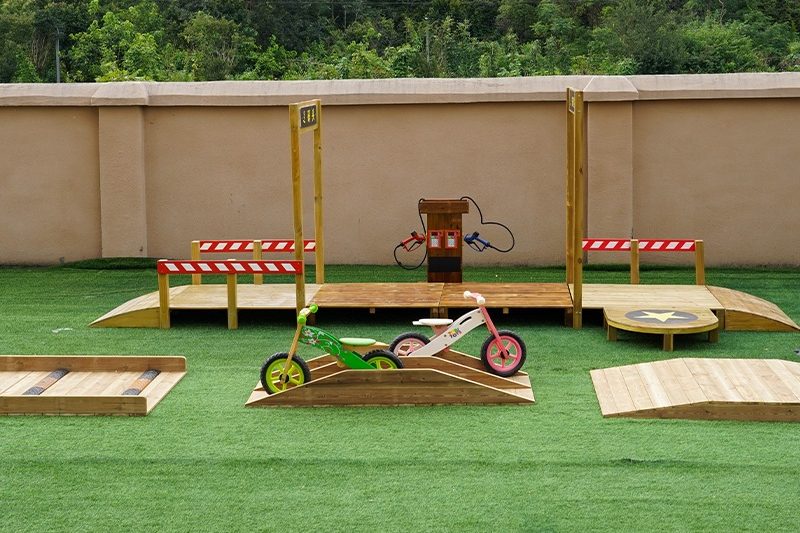
Effective implementation of outdoor games for preschoolers requires thoughtfully designed spaces that balance safety with developmental appropriateness. When establishing or upgrading outdoor learning environments, consider these evidence-based principles:
Safety Surface Requirements
The Consumer Product Safety Commission provides specific guidelines for playground surfacing under and around equipment where falls might occur:
- Critical Height Zones: Install impact-absorbing surfaces under equipment exceeding 18 inches in height
- Material Options: Rubber mulch, engineered wood fiber, poured-in-place rubber, or interlocking rubber tiles
- Depth Requirements: Loose-fill materials should maintain minimum 9-12 inch depth
- Inspection Schedule: Check surface integrity weekly and replenish materials quarterly
Equipment Spacing Standards
Proper spacing between play structures prevents collisions and ensures adequate supervision lines of sight:
- Minimum 12-foot buffer zones between active play equipment
- Clear sightlines from multiple supervision points
- Defined pathways connecting activity areas without crossing active play zones
- Age-appropriate zoning separating equipment for different developmental stages
Quality Equipment Selection
Institutional-grade outdoor games for preschoolers equipment differs significantly from residential products in durability, safety features, and educational value:
Wooden Play Equipment Advantages:
- Longevity: Commercial-grade wooden structures endure 15-20 years with proper maintenance
- Low Toxicity: Natural wood eliminates concerns about plastic chemicals or metal heat retention
- Aesthetic Integration: Wooden structures blend harmoniously with natural surroundings
- Splinter Prevention: Properly treated and sanded commercial wood poses minimal splinter risk
- Sustainability: Responsibly sourced wood supports environmental education values
Critical Safety Features:
- Rounded edges and smooth surfaces
- Secure fastening with no protruding hardware
- Non-toxic finishes and treatments
- Regular maintenance protocols
- Age-appropriate dimensions
Weather Considerations
Different climates require specific adaptations for year-round outdoor games for preschoolers:
Hot Climates:
- Shade structures over active play areas
- Metal equipment covered to prevent burns
- Shaded water stations for hydration
- Heat index monitoring protocols
Cold Climates:
- Heated observation areas for staff
- Insulated storage for outdoor equipment
- Snow removal procedures maintaining safe pathways
- Cold weather activity modifications
Rainy Environments:
- Well-draining surfaces preventing puddle accumulation
- Covered areas for transition activities
- Proper drainage systems protecting play surfaces
- Weather-resistant equipment materials
Seasonal Adaptations for Year-Round Play

Successful early childhood programs implement outdoor games for preschoolers throughout the entire year, adapting activities to seasonal conditions while maintaining developmental benefits.
Spring Outdoor Activities
Thematic Focus: Growth, renewal, and environmental changes
Recommended Games:
- Puddle Jumping: Measure puddles before and after rain, introducing measurement concepts
- Seed Planting: Plant fast-growing seeds and maintain garden observation journals
- Bird Nest Discovery: Observe nest-building and discuss animal homes
- Flower Petal Collection: Sort petals by color and size for mathematical learning
Equipment Emphasis: Weather-resistant wooden gardening tools, rain gear, collection containers
Educational Connection: Link activities to life science curriculum covering growth cycles and habitats.
Summer Outdoor Activities
Thematic Focus: Water exploration, extended outdoor time, nature observation
Recommended Games:
- Water Table Investigations: Float/sink experiments with various objects
- Shadow Measurement: Track shadow changes throughout day, introducing time concepts
- Insect Observation: Use magnifying glasses to examine and sketch insects safely
- Color Mixing Outdoors: Paint with water on pavement, mix colors, observe evaporation
Equipment Emphasis: Water tables, UV-protected shaded areas, lightweight clothing storage, hydration stations
Safety Priority: Implement sun protection protocols, frequent hydration breaks, heat index monitoring.
The Centers for Disease Control recommends limiting outdoor activities when heat index exceeds 90°F for young children.
Fall Outdoor Activities
Thematic Focus: Seasonal changes, harvest, preparation for winter
Recommended Games:
- Leaf Collection and Sorting: Classify by shape, color, size; create patterns
- Apple Picking Dramatic Play: Set up pretend orchard with baskets and wooden apples
- Migration Observation: Watch and discuss birds preparing for migration
- Acorn and Pinecone Math: Count, sort, create sets for early mathematics
Equipment Emphasis: Rakes, collection baskets, nature identification guides, warm outdoor clothing
Curriculum Integration: Discuss seasonal cycles, animal preparation, weather changes.
Winter Outdoor Activities
Thematic Focus: Weather observation, animal adaptation, sensory exploration
Recommended Games:
- Snow Property Experiments: Compare snow, slush, ice; observe melting processes
- Animal Track Identification: Find and identify prints in snow, create track guides
- Ice Painting: Freeze colored water in containers, paint with ice blocks
- Winter Scavenger Hunt: Search for evergreens, birds, animal signs, winter berries
Equipment Emphasis: Insulated clothing, snow tools, thermometers, warm-up spaces
Cold Weather Safety: The American Academy of Pediatrics recommends limiting outdoor time to 30-minute intervals when temperatures drop below 32°F, with frequent indoor warm-up breaks.
Equipment Recommendations for Educational Settings
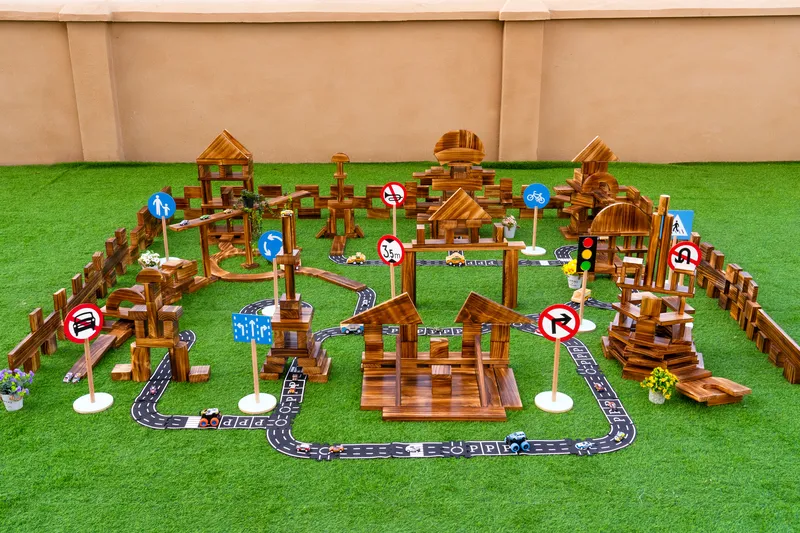
Educational institutions investing in outdoor games for preschoolers equipment should prioritize quality, safety, and educational value. Here are evidence-based recommendations for building comprehensive outdoor learning environments:
Essential Equipment Categories
Gross Motor Development Equipment
Climbing Structures:
- Wooden climbing frames (3-6 feet height)
- Natural log climbing arrangements
- Rope ladders with wooden rungs
- Rock wall panels (low-level, preschool-appropriate)
Balance Equipment:
- Wooden balance beams (various heights: ground level, 6 inches, 12 inches)
- Stepping stones in different configurations
- Wobble boards and balance discs
- Natural log balance trails
Active Play Equipment:
- Wooden slides (3-4 feet height)
- Tunnels for crawling
- Age-appropriate swings with safety surfacing
- Tricycles and wheel toys with storage
Fine Motor Development Equipment
Manipulative Toys:
- Large wooden building blocks (outdoor set)
- Natural loose parts (logs, stumps, branches)
- Wooden puzzles with weather-resistant coating
- Lacing boards and threading activities
Creative Materials:
- Outdoor art easels (wooden, adjustable)
- Wooden chalkboards (large-scale)
- Sand and water tables with tool sets
- Mud kitchen with cooking utensils
Cognitive Development Equipment
Educational Games:
- Wooden alphabet and number sets (large format)
- Shape sorting stations
- Color matching games
- Size sequencing materials
Science Exploration:
- Magnifying glasses (class set)
- Collection containers with compartments
- Thermometers and weather instruments
- Binoculars for nature observation
Social-Emotional Learning Equipment
Cooperative Play:
- Large parachutes for group games
- Balance boards requiring partner cooperation
- Group construction materials
- Musical instruments for outdoor music circle
Dramatic Play:
- Outdoor playhouse or fort
- Wooden market stand for pretend play
- Dress-up storage for outdoor role-play
- Vehicle toys encouraging cooperative scenarios
Budget-Conscious Purchasing Strategies
Educational institutions can implement comprehensive outdoor games for preschoolers programs through strategic purchasing:
Year One Priorities (Essential Core):
- Safety surfacing under high-use areas
- Primary climbing/sliding structure
- Basic balance equipment set
- Sand and water play stations
- Wheel toys and pathway system
Year Two Expansion (Enhanced Learning): 6. Dramatic play structures 7. Music and movement equipment 8. Art and creative expression stations 9. Nature observation tools 10. Additional loose parts materials
Year Three Enhancement (Complete Program): 11. Specialized seasonal equipment 12. Technology integration (weather monitoring) 13. Specialized accessibility equipment 14. Advanced STEM materials 15. Documentation and storage systems
Supplier Selection Criteria
When sourcing equipment for outdoor games for preschoolers, educational buyers should evaluate:
Quality Indicators:
- ASTM F1487 Standard Consumer Safety Performance Specification compliance
- IPEMA (International Play Equipment Manufacturers Association) certification
- Manufacturer warranty terms (minimum 5-year structural warranty)
- Replacement parts availability
- Maintenance support and guidance
Sustainability Factors:
- Sustainably sourced wood (FSC or PEFC certified)
- Low-VOC finishes and treatments
- Minimal plastic components
- Longevity and durability ratings
- End-of-life recyclability
Educational Value:
- Alignment with early childhood learning standards
- Multi-age adaptability
- Open-ended play potential
- Skill progression opportunities
- Curriculum integration resources
Implementing Outdoor Games in Curriculum
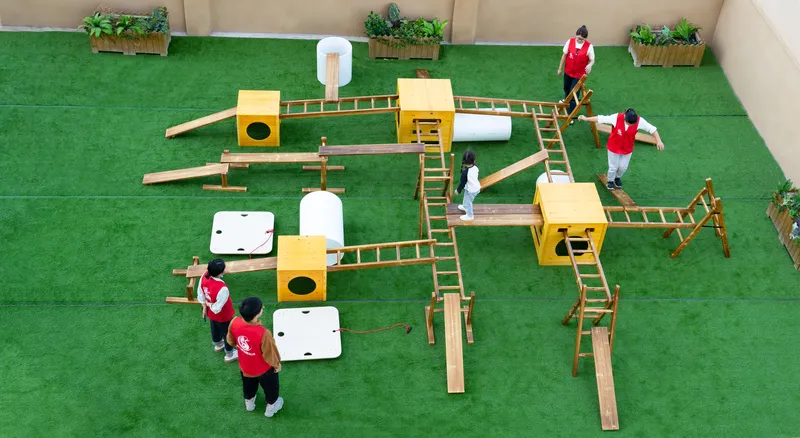
Effective integration of outdoor games for preschoolers requires intentional curriculum planning that connects outdoor experiences with classroom learning objectives.
Daily Schedule Integration
Research from the National Association for the Education of Young Children recommends preschoolers engage in outdoor play for 60-90 minutes daily, distributed across multiple sessions:
Optimal Daily Structure:
- Morning outdoor time: 30-45 minutes of active play and exploration
- Mid-day outdoor time: 20-30 minutes focused on specific learning objectives
- Afternoon outdoor time: 20-30 minutes for free play and social interaction
Curriculum Connections
Literacy Integration:
- Read nature-themed books before outdoor exploration
- Create outdoor word walls featuring vocabulary from outdoor experiences
- Dictate and record stories about outdoor adventures
- Practice letter formation in sand or with natural materials
Mathematics Integration:
- Count natural objects collected during outdoor games
- Sort and classify items by attributes
- Create patterns with natural materials
- Measure distances, heights, and quantities
Science Integration:
- Observe weather changes and document findings
- Study plant and animal life cycles
- Conduct simple experiments using natural materials
- Investigate properties of materials (solids, liquids, textures)
Social Studies Integration:
- Discuss community helpers who work outdoors
- Study different outdoor environments and cultures
- Practice cooperation and conflict resolution during group games
- Learn about environmental stewardship and conservation
Assessment and Documentation
Quality early childhood programs systematically assess children’s development through outdoor games for preschoolers:
Observation Methods:
- Anecdotal records of skill demonstrations
- Photographic documentation of play sequences
- Video recordings highlighting specific competencies
- Developmental checklists completed during outdoor time
Progress Monitoring:
- Track gross motor milestone achievement
- Document social interaction quality and frequency
- Record vocabulary development related to outdoor experiences
- Note problem-solving strategies employed during play
Staff Training and Professional Development
Successful implementation of outdoor games for preschoolers requires adequately trained staff who understand both child development principles and outdoor learning pedagogy.
Essential Training Components
Safety and Risk Management:
- Equipment inspection protocols
- Injury prevention strategies
- Weather-related safety decisions
- Emergency procedure familiarity
- First aid and CPR certification
Pedagogical Approaches:
- Recognizing and extending learning moments
- Asking open-ended questions during play
- Balancing child-directed and teacher-guided activities
- Documenting learning for assessment purposes
- Connecting outdoor experiences to curriculum standards
Inclusive Practices:
- Adapting outdoor games for children with diverse abilities
- Providing multiple means of engagement and expression
- Creating sensory-friendly outdoor spaces
- Supporting dual language learners in outdoor contexts
- Recognizing and responding to individual learning styles
Professional Development Resources
Organizations offering specialized training in outdoor games for preschoolers:
- Nature Explore – Nature-based learning certification
- Children & Nature Network – Webinars and resources
- Dimensions Educational Research Foundation – Outdoor learning curricula
- Local community colleges – Early childhood outdoor education courses
- State and regional early childhood conferences – Outdoor learning sessions
Engaging Families in Outdoor Play
Family engagement significantly enhances the benefits children derive from outdoor games for preschoolers. Educational settings should implement strategies that extend outdoor learning into home environments.
Communication Strategies
Regular Updates:
- Weekly newsletters highlighting outdoor learning activities
- Photo displays showing outdoor game participation
- Video clips shared via secure platforms
- Documentation panels explaining educational objectives of outdoor play
Educational Resources:
- Handouts suggesting simple outdoor games for home
- Lists of natural materials beneficial for collection
- Seasonal activity calendars for family implementation
- Safety guidelines for outdoor play supervision
Family Participation Opportunities
Scheduled Events:
- Outdoor Play Mornings: Families join classes for structured outdoor games
- Nature Walk Events: Guided explorations led by educators or naturalists
- Build Days: Families collaborate to enhance outdoor learning spaces
- Seasonal Celebrations: Outdoor festivals highlighting seasonal changes
Ongoing Involvement:
- Material Collection: Families donate natural loose parts for outdoor play
- Garden Assistance: Parents support planting and maintenance of outdoor gardens
- Documentation: Families share photos and stories of outdoor experiences at home
- Equipment Building: Parent workshops creating simple outdoor games equipment
According to research published by Harvard Family Research Project, children whose families engage with their educational program show 25-30% greater skill development across all domains.
Addressing Common Challenges
Early childhood programs implementing outdoor games for preschoolers frequently encounter predictable challenges. Here are evidence-based solutions:
Challenge: Limited Outdoor Space
Solutions:
- Maximize vertical space with climbing walls and hanging equipment
- Rotate equipment weekly to provide variety despite space constraints
- Schedule outdoor time in shifts for smaller group access
- Partner with nearby parks for extended outdoor learning opportunities
- Create multi-functional zones that serve different purposes throughout the day
Case Example: A urban preschool with only 800 square feet of outdoor space implemented a rotation system featuring three distinct setups: gross motor (Monday-Tuesday), art and sensory (Wednesday-Thursday), dramatic play and nature exploration (Friday). This approach provided comprehensive outdoor games for preschoolers despite space limitations.
Challenge: Adverse Weather Conditions
Solutions:
- Invest in quality rain gear enabling outdoor play in light rain
- Create partially covered spaces for transitional weather
- Develop indoor gross motor alternatives for severe weather days
- Maintain flexible scheduling adapting to weather patterns
- Educate families about benefits of outdoor play in various conditions
Weather Policy Development: Establish clear temperature and weather thresholds determining outdoor play cancellation, ensuring consistency and safety.
Challenge: Budget Constraints
Solutions:
- Prioritize open-ended, multi-use equipment over single-purpose items
- Source natural loose parts at no cost (sticks, stones, leaves, pinecones)
- Apply for early childhood education grants focused on outdoor learning
- Organize fundraising specifically for outdoor environment enhancement
- Build simple equipment during staff professional development sessions
Cost-Effective Alternatives:
- Painted ground patterns replace purchased equipment
- Donated tree stumps and logs create natural climbing spaces
- Community-sourced tires become versatile play elements
- Parent-built wooden structures supplement commercial equipment
Challenge: Staff Resistance to Outdoor Learning
Solutions:
- Provide high-quality professional development about outdoor learning benefits
- Start with small, manageable outdoor activities building confidence gradually
- Assign outdoor learning champions within staff to mentor colleagues
- Share research demonstrating educational outcomes of outdoor games for preschoolers
- Address specific concerns (weather, supervision, behavior management) with training and support
Leadership Role: Administrative support and modeling proves essential for cultural shift toward outdoor learning priority.
Measuring Success and Outcomes
Educational institutions must demonstrate that investment in outdoor games for preschoolers produces measurable developmental outcomes. Implement systematic assessment approaches:
Developmental Progress Tracking
Physical Development Indicators:
- Gross motor skill milestone achievement rates
- Balance and coordination improvements
- Fine motor skill development through outdoor manipulation
- Overall physical fitness and endurance growth
Cognitive Development Indicators:
- Problem-solving strategy complexity
- Question-asking frequency and sophistication
- Attention span duration during outdoor activities
- Memory recall of outdoor learning experiences
Social-Emotional Development Indicators:
- Peer interaction quality and frequency
- Conflict resolution strategy effectiveness
- Emotional regulation during challenging activities
- Leadership and followership skill demonstrations
Language Development Indicators:
- Vocabulary expansion from outdoor experiences
- Narrative complexity in describing outdoor activities
- Question formation related to natural phenomena
- Peer conversation length and depth during outdoor play
Program Evaluation Methods
Quantitative Data:
- Percent of children meeting age-appropriate developmental milestones
- Average daily outdoor play time per child
- Equipment utilization rates across different areas
- Injury rates comparing outdoor vs. indoor environments
Qualitative Data:
- Parent satisfaction surveys regarding outdoor learning emphasis
- Staff reflections on outdoor games effectiveness
- Children’s comments and representations of outdoor experiences
- Photographic documentation showing engagement quality
Comparison Studies:
- Achievement comparisons between current and previous years
- Parallel analysis with similar programs with minimal outdoor focus
- Longitudinal tracking following children into elementary school
- Benchmark comparisons against state or national standards
Research published in the American Journal of Play demonstrates that children participating in regular, high-quality outdoor games for preschoolers show statistically significant advantages in all developmental domains compared to peers with limited outdoor play opportunities.
Conclusion: Building Future Success Through Outdoor Play
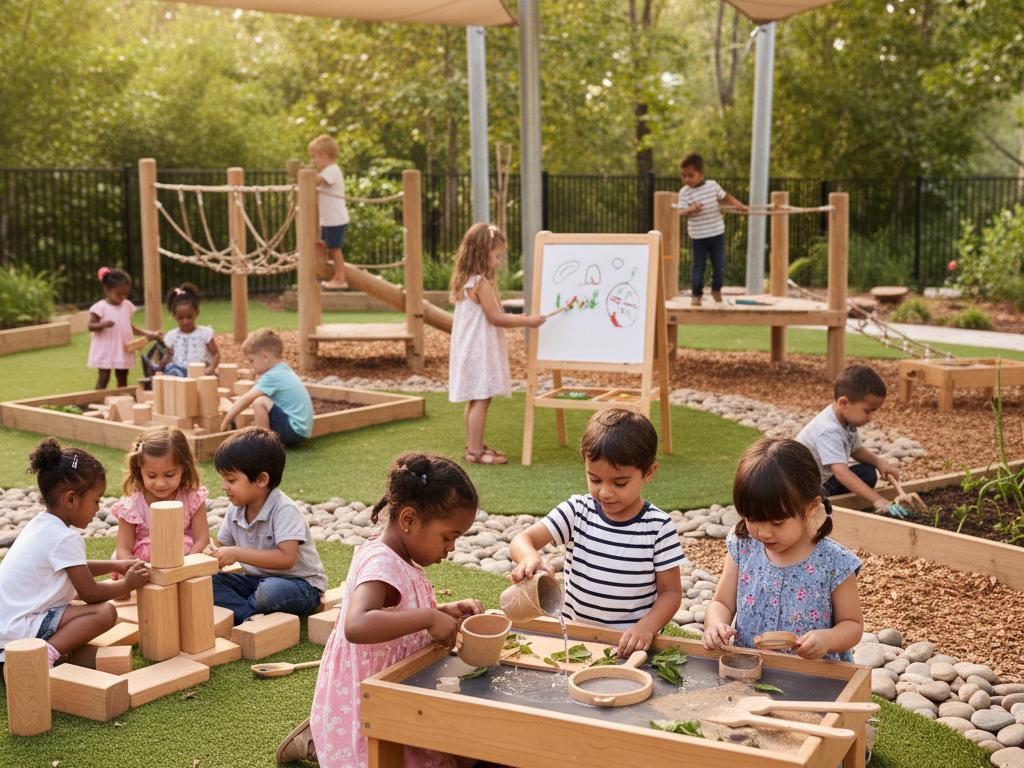
The evidence supporting outdoor games for preschoolers as essential components of quality early childhood education continues to grow. When children engage with nature through structured outdoor play experiences, they develop foundational competencies supporting lifelong learning and well-being.
Key Takeaways for Educational Institutions
Investment Priorities:
- Quality, durable equipment supporting developmental progression
- Professional development ensuring staff outdoor learning competency
- Safety infrastructure meeting or exceeding regulatory standards
- Natural materials and loose parts encouraging open-ended play
- Documentation systems tracking developmental outcomes
Implementation Essentials:
- Daily outdoor time integrated into core curriculum
- Year-round outdoor play with appropriate seasonal adaptations
- Balance between child-directed and teacher-guided outdoor experiences
- Family engagement strategies extending learning beyond the center
- Continuous program evaluation and improvement
Looking Forward: Outdoor Learning Trends
The early childhood education field increasingly recognizes outdoor games for preschoolers as non-negotiable program elements. Emerging trends include:
Nature-Based Preschools: Programs conducting 50-100% of daily activities outdoors, even in challenging climates. Research indicates these programs produce equivalent or superior academic outcomes while significantly enhancing physical development and environmental awareness.
Forest School Approaches: Regular, repeated sessions in natural woodlands helping children develop comprehensive skills through unstructured exploration. Originating in Scandinavia, these approaches demonstrate remarkable effectiveness in building confidence, creativity, and resilience.
Outdoor Learning Certification: Professional certifications specifically focused on outdoor education pedagogy, raising standards and ensuring quality implementation.
Technology Integration: Thoughtful incorporation of digital tools (documentation apps, nature identification software, digital microscopes) enhancing rather than replacing outdoor exploration.
Taking the Next Step
For educational leaders considering enhanced outdoor games for preschoolers programming:
- Assess current outdoor environment against best practice standards
- Survey stakeholders (staff, families, children) about outdoor learning priorities
- Develop strategic plan for outdoor environment enhancement
- Budget appropriately for quality equipment and ongoing maintenance
- Invest in professional development ensuring successful implementation
- Document outcomes demonstrating program effectiveness and return on investment
The children in your care deserve rich, developmentally appropriate outdoor experiences that build strong bodies, curious minds, and compassionate hearts. Quality outdoor games for preschoolers programming delivers these outcomes while creating joyful childhood memories that last lifetimes.
Partner with Quality Providers
When selecting equipment suppliers for your outdoor learning environment, prioritize manufacturers demonstrating:
- Commitment to sustainable, eco-friendly materials
- Understanding of early childhood development principles
- Dedication to safety standards exceeding minimum requirements
- Willingness to customize solutions for unique program needs
- Ongoing support and professional development resources
Quality wooden educational toys and outdoor equipment represent investments in children’s futures. Choose suppliers who share your commitment to excellence in early childhood education.